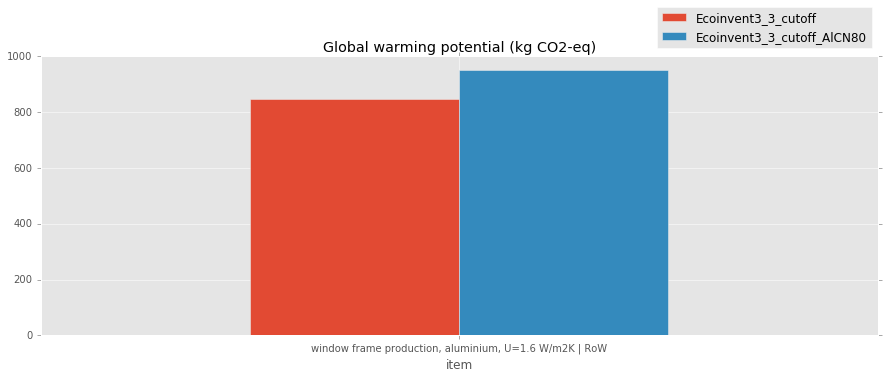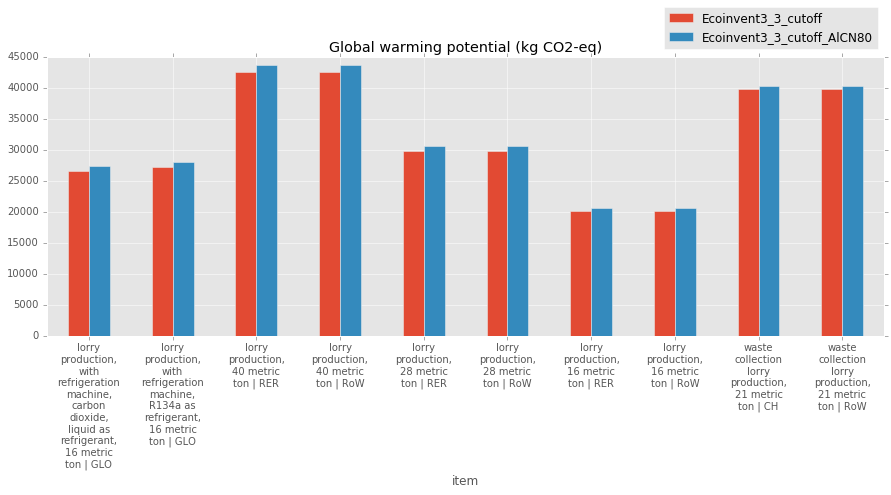Manipulating markets in ecoinvent 3 using Ocelot
Note: this post is based on a jupyter notebook, available here
The challenge
LCA can be a powerful tool for demonstrating the environmental credentials of products and technologies that are in development. When future products or technologies are assessed using LCA, while the foreground system can be manipulated to reflect the world they are likely to be released into, the background system is static, reflecting current technology mixes. This might lead to inconsistencies when assessing future scenarios using LCA.
For example, decarbonisation of the electricity grid is likely to improve the global warming impact associated with the life cycle of electric vehicles. In a standard LCA, the foreground system can be altered to utilise lower carbon electricity sources in the use phase. It may also be possible to alter the electricity mix used by the assembly process and the production of key components. However, as the supply chain gets more and complex and intertwined, manual edits to the electricity mix used become burdensome.
Similarly, aluminium is replacing steel in a number of new products with it’s lightweight properties billed as reducing environmental impact (e.g. car engine blocks (Bonollo et al. 2006)). However, concurrently the production of aluminium is shifting towards China. From almost a standing start in the late 90’s, China accounted for over half of primary aluminium production in 2015.

Aluminium smelting requires a large amount of electricity (around 14 kWh/kg), which in China is mainly produced at coal fired power stations. As a result, the net benefits from lightweighting may diminish as the impact of aluminium production with coal power increases.
By making targeted alterations to the system model that builds the background database, markets for exchanges such as electricity, aluminium, or any other exchange, can be updated database-wide to reflect the future scenario we are seeking to assess with our LCA. If the process is simple enough, powerful sensitivity analyses may be possible where products or technologies can be tested out according to a variety of possible future scenarios.
The idea
Ocelot is an open source software being developed by Chris Mutel at PSI and ecoinvent to allow LCA practitioners to manipulate system models. In order to create markets, the Ocelot linking algorithm uses the relative share of production volumes in the regions contained within that market to allocate and despatch the demand. By editing the production volumes of targeted transformation processes during the construction of the system model, the resulting markets can be manipulated to represent any mix desired by the user.
Visual representation

So what could a further move in the aluminium market towards China mean?
Using Ocelot as a basis, we can create a new system model in which more primary aluminium production takes place in China (a full explanation of how can be found here. In the below example, we are looking at a possible future scenario where 80% of primary ingot is produced in China (with the proportion of production from the rest of the world held constant). Given the current rate of growth of China’s market share, this may become a reality in the next decade.
We can use Ocelot to change the market for ‘aluminium production, primary, ingot RoW’
| Location | Before | After |
|---|---|---|
| China | 50.61% | 80.0% |
| IAI Area, Russia & RER w/o EU27 & EFTA | 9.57% | 3.9% |
| IAI Area, Gulf Cooperation Council | 8.37% | 3.4% |
| IAI Area, Asia, without China and GCC | 6.93% | 2.8% |
| Quebec | 5.95% | 2.3% |
| IAI Area, North America, without Quebec | 5.15% | 2.1% |
| UN-OCEANIA | 4.99% | 2.0% |
| IAI Area, South America | 4.69% | 1.9% |
| IAI Area, Africa | 3.74% | 1.5% |
Using brightway2, an open source framework for LCA, also developed by Chris Mutel at PSI, we can investigate the effect of this shift eastwards on the environmental impact of aluminium and aluminium containing products.
Aluminium production
| Process | Original database (kg CO2-eq) |
Altered database (kg CO2-eq) |
Percentage difference (%) |
|---|---|---|---|
| market for aluminium, primary, ingot RoW | 18.05 | 20.64 | 14.38% |

The global warming impact of the RoW market for primary aluminium ingot and GLO markets for wrought and cast alloy (which take primary ingot as an input) have been affected by the changes to the system model. They have increased by around 14%. This is likely to be due to the predominant use of electricity from coal in the Hall-Héroult process.
It’s interesting to note that the market for aluminium in the EU (where no aluminium is imported from China) is relatively unaffected, with only a 0.03% increase in impact. This means that we haven’t directly affected this market, but the changes we’ve made to RoW aluminium seem to have propagated through the database and led to a slight increase as a result of distant inputs to the process. This is exactly what we wanted.
Products known to contain aluminium
We can extend our analysis explore the propagation of our changes through the background database. Switching back to GWP impact, we can look at products which we know to contain aluminium, for example aluminium window frames. Again we can see that we have brought about an increase, this time of (12.34%) as a result of increasing the impact of aluminium.
| Process | Original database (kg CO2-eq) |
Altered database (kg CO2-eq) |
Percentage difference (%) |
|---|---|---|---|
| window frame production, aluminium, U=1.6 W/m2K RoW | 845 | 950 | 12.34% |

Looking more broadly
Taking a broader approach, we can look at things that are likely to have aluminium in their supply chain as a component of a constituent part, for example lorries. Here we can see that the percentage differences as a result of our changes vary between about 1.5% and 3%, most likely related to the amount of aluminium in the design.
| Process | Original database (kg CO2-eq) |
Altered database (kg CO2-eq) |
Percentage difference (%) |
|---|---|---|---|
| lorry production, with refrigeration machine, carbon dioxide, liquid as refrigerant, 16 metric ton GLO | 26,623 | 27,435 | 3.1% |
| lorry production, with refrigeration machine, R134a as refrigerant, 16 metric ton GLO | 27,285 | 28,097 | 3.0% |
| lorry production, 40 metric ton RoW | 42,533 | 43,633 | 2.6% |
| lorry production, 28 metric ton RoW | 29,866 | 30,574 | 2.4% |
| lorry production, 16 metric ton RoW | 20,207 | 20,645 | 2.1% |
| waste collection lorry production, 21 metric ton RoW | 39,767 | 40,343 | 1.6% |

So what now?
Using Ocelot, LCA practitioners can manipulate the make up of markets within the ecoinvent database in such a way that these changes propagate through the database and influence the entire background system. We can use this capability to ask interesting questions and perform interesting sensitivity analyses.
The market_manipulator module which allows this is available on my github page here
With two commands…
from market_manipulator import system_model_with_pv_edits
fp, data = system_model_with_pv_edits('path/to/unlinked/spold/files', 'path/to/csv/file')
…the production volumes, and hence the resulting market for a given exchange can be edited.
I’ll keep you posted on any future developments. If you have any questions, get in touch via Twitter @KTH_James